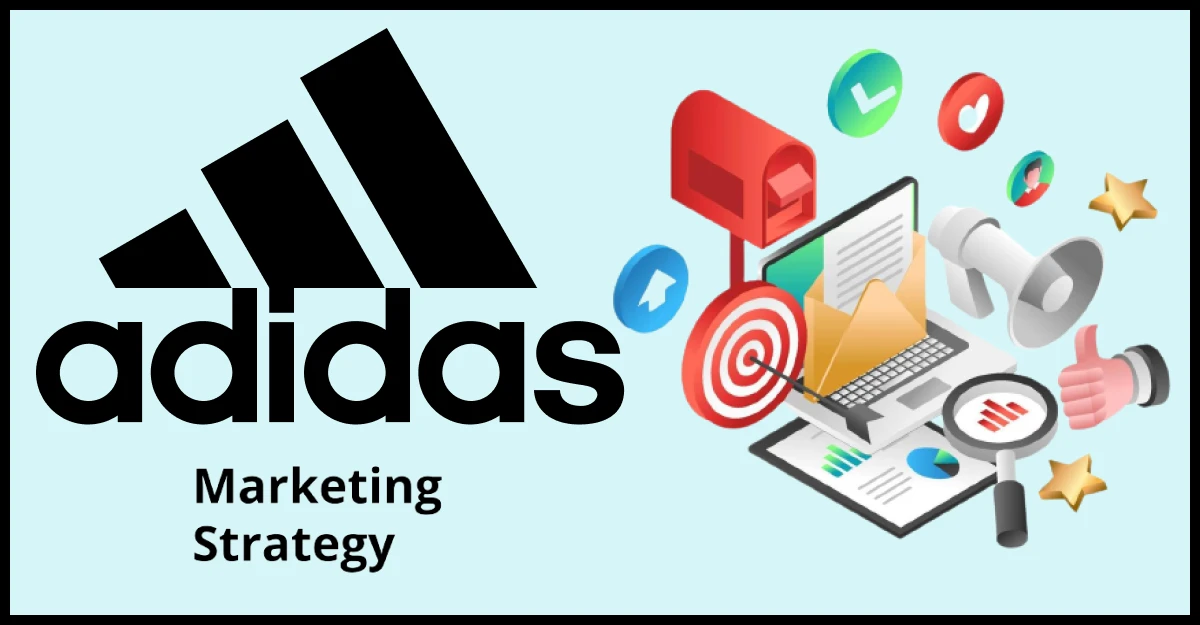In today’s world, Adidas has become synonymous with sportswear! Do you know how it became a cool brand that won the hearts of millions? The core reason is- Adidas marketing strategy. Yes! It’s advertisements that you see all over the television, YouTube, banners, social media, etc.

No doubt that its products are of top-notch quality but it is not a cakewalk for a German-based company to spread its arms all over the globe just by offering supreme products. It needs to create awareness like- “Hello! We are offering the best sporting goods with limited edition… So please hurry up and buy it!”
That’s what we call marketing, no?
So, in this write-up, we will analyze the Adidas Marketing Strategy right from its inception to becoming the king of the sportswear industry.
Also, in the form of a bonus, we will find out what other brands can learn from Adidas marketing strategy.
Stay tuned!
(A) Adidas: A Brief Overview
Adidas, a global powerhouse in sportswear, has seamlessly fused athletic prowess with cultural coolness. Founded in 1949, the brand has evolved beyond its sportswear origins to become a lifestyle icon. Renowned for its iconic three-striped logo, Adidas boasts a diverse product range spanning footwear, apparel, and accessories.
Before diving deeper into the Adidas marketing strategy, let’s have a look at its profile-
| Particulars | Adidas AG |
| Former Names | Gebrüder Dassler Schuhfabrik (1924–1949) |
| Type of Company | Publicly Listed |
| Market Capitalization | EUR 30.50 billion |
| Operating Industry | Textile, footwear |
| Market Share (2023) | 14.7% |
| Founded | July 1924; 99 years ago in Herzogenaurach, Germany (as Gebrüder Dassler Schuhfabrik) 18 August 1949; 74 years ago (as Adidas) |
| Founder | Adolf Dassler |
| Headquarters | Herzogenaurach, Bavaria, Germany |
| Area Served | Worldwide (except North Korea, Russia, Turkmenistan, Afghanistan, South Sudan, Chad and Palestine) |
| Products | Apparel, footwear, sportswear, sports equipment, toiletries |
| Competitors | Nike, PUMA, Reebok, ASICS Europe, HanesBrands, etc. |
From the soccer fields to the streets, Adidas has left an indelible mark with groundbreaking innovations and trendsetting collaborations. Embracing a commitment to sustainability, the brand continues to shape the future of fashion and athleticism. Adidas’s legacy is not just about sportswear; it’s a cultural phenomenon that resonates globally, transcending generations.
A Quick Note
Despite being known as the king of sportswear brands, Adidas faces tough competition with major two players i.e. Nike and PUMA. So we have thrown a detailed comparison analysis at the request of our readers. Here are those-
- Adidas vs PUMA: Which one is leading the market?
- Adidas vs Nike: Which one is better and ruling the market?
Also, we have covered- Adidas & Indian Cricket Team: A Win-Win Sponsorship Story.
Don’t forget to check out these interesting articles… After all, you are a huge fan of Adidas too:)
(B) Target Customer: STP of Adidas

Imagine you are the owner of a company and you want to expand your reach. So what will be your first step before planning an advertisement? To determine the target audience or target customer segment! That’s what Adidas did before launching its marketing campaigns.
This is an essential part of Adidas marketing strategy.
Oh wait! Let me tell you what STP stands for in marketing.
Look, STP stands for Segmentation, Targeting, and Positioning. These are the three basic steps that you must identify as a marketer to identify the right customer and serve them the right message or give them the correct information about your product or service.
So, let’s break down the STP of Adidas-
(B.1) Segmentation: Understand the Crowd
Adidas smartly divides its vast market into segments based on shared characteristics. Whether you’re a fitness fanatic, a fashion-forward trendsetter, or an aspiring athlete, Adidas has a product tailored just for you. By identifying these groups, Adidas ensures that its offerings resonate with diverse consumer needs and preferences.
(B.2) Targeting: Precision in Focus
Adidas sets precise targets by directing its efforts towards specific market segments. For urban trendsetters, there’s Adidas Originals; for athletes, specialized sportswear lines are crafted. By concentrating on well-defined demographics, Adidas ensures that its messaging resonates with the intended audience, creating a more impactful connection.
(B.3) Positioning: Crafting Identity with Purpose
In a saturated sportswear landscape, Adidas strategically positions itself by emphasizing its unique identity. The brand goes beyond merely selling products; it cultivates a lifestyle. Through distinctive design elements and strategic collaborations, Adidas positions itself as a symbol of authentic self-expression.
This deliberate positioning fosters a connection with consumers, transforming Adidas into more than a sportswear choice but a statement of personal identity.
(C) Key Principles of Adidas Marketing Strategy: Marketing Mix of 7Ps
Let’s look at the key principles of Adidas marketing strategy. These are the secret mantras used by Adidas to win the hearts and minds of their customers.
(C.1) Product: Innovation Beyond Limits

The making of super comfortable shoes or sportswear requires proper research and development. Adidas, renowned for groundbreaking sports innovation, continuously diversifies its product portfolio. From BOOST technology revolutionizing footwear comfort to sustainable materials like Primeblue, Adidas products reflect a commitment to performance and style. The brand’s collaborations, such as Adidas x Parley for the Oceans, exemplify a dedication to environmental responsibility.
(C.2) Pricing: Strategic Balance for All Budgets
Adidas strategically positions its pricing to cater to a broad consumer spectrum. Adidas has immensely used the premium pricing strategy and positioned itself as a high-end brand. However, to expand the user base, it needs to offer products in an affordable price range too!
While premium products showcase cutting-edge technology, the brand maintains affordable options as well. The Yeezy and Ultraboost lines coexist with more accessible collections, ensuring that Adidas remains inclusive and accessible to a diverse global audience.
(C.3) Place: Global Reach, Local Impact
Adidas strategically places its products worldwide, leveraging both physical and digital channels. Operating in over 160 countries, the brand’s extensive retail network, including flagship stores and partnerships, ensures a pervasive global presence.
Let’s look at the market share of Adidas in different regions-
| Regions | Market Share |
| EMEA (Europe, Middle East, and Africa) | 38% |
| North America | 28% |
| Greater China | 14% |
| Asia Pacific | 10% |
| Latin America | 9% |
Simultaneously, e-commerce initiatives and collaborations with popular online platforms extend Adidas’s reach to the digital realm.
(C.4) Promotion
Adidas elevates its brand through strategic collaborations, transcending traditional marketing. Iconic partnerships with influencers, artists, and athletes, like the long-standing association with Kanye West, amplify Adidas’s cultural relevance. Engaging storytelling and captivating campaigns further solidify its position as a brand intertwined with global culture.
We will look into the details in the upcoming sections.
(C.5) People: Athletes and Ambassadors as Brand Advocates
Adidas strategically aligns with athletes and influencers as brand ambassadors. From football legends like Lionel Messi to cultural icons like Beyoncé, Adidas leverages these partnerships to embody its brand values. This human connection enhances authenticity, fostering consumer trust and loyalty.
Let me give you an interesting example. Adidas launched wise initiatives like “Creating Lasting Change” to fight discrimination. It aimed to promote equality and fairness in the workforce. And it was quite successful too!
(C.6) Process: Sustainable Practices, Ethical Pathways
Adidas places a strong emphasis on sustainable processes throughout its supply chain. The brand’s “End Plastic Waste” initiative and commitment to reducing carbon emissions underscore its dedication to ethical and eco-friendly practices. Transparent reporting on sustainability metrics reflects Adidas’s responsible approach to its operational processes.
Do you know, that Adidas introduced 3D printing and automation to reduce the waste in the entire manufacturing process?
Well, that’s a secret recipe to survive. You need to protect the natural environment to thrive in the market.
(C.7) Physical Evidence: Flagship Stores and E-commerce Platforms

Adidas strategically utilizes physical evidence to enhance the brand experience. Flagship stores, like the Adidas NYC Fifth Avenue store, are immersive spaces showcasing innovation. The physical presence reinforces the brand’s premium image, while events and experiential marketing create tangible connections with consumers, leaving a lasting impression.
Also, it is not far behind in the competitive space of e-commerce platforms. It has its own window shopping portal (e-commerce platform) that offers fast and reliable delivery options with superb product packaging.
Guess what?
They claim that they use recycled and eco-friendly materials for packaging their products.
Adidas has over 500 independent factories across 55 countries. Their products are available in mega marts like Walmart, Amazon, Myntra, etc.
Thus, Adidas’s 7Ps marketing mix epitomizes a holistic strategy, seamlessly intertwining product excellence, global accessibility, cultural relevance, and sustainable practices to become one of the most successful brands.
(D) Adidas Marketing Strategy
Adidas mainly works on two types of marketing i.e. Traditional and Digital. Let’s look at them one by one-
(D.1) Traditional Marketing Strategy of Adidas
The following points describe the traditional aspects of Adidas marketing strategy-
Sponsorship: Global Athletic Alliances

Adidas strategically aligns with high-profile sports events and teams, such as being an official sponsor of NBA, MLS, Olympics, FIFA, and UEFA tournaments. This sponsorship strategy not only provides extensive global visibility but also associates the brand with the pinnacle of athletic achievement.
Adidas has sponsored famous athletes like Lionel Messi, James Jardem, Naomi Osaka, etc.
Celebrity Endorsements: Icons Wearing the Stripes
Adidas leverages the star power of athletes and celebrities as brand ambassadors. From soccer legends like Lionel Messi to cultural influencers like Pharrell Williams, these endorsements amplify brand visibility and connect Adidas with the aspirational lifestyles of its target audience.
Innovative Product Launches: Setting Trends with Technology
Adidas excels in unveiling innovative products that capture consumer attention. Notable launches include the BOOST technology for superior cushioning and the collaboration with Kanye West for the Yeezy line. These strategic product launches create buzz, driving both sales and brand perception.
Engaging Advertising Campaigns: Storytelling with Impact
Adidas crafts compelling advertising campaigns that go beyond product features, telling stories that resonate with consumers. The “Impossible is Nothing” campaign and the “All In” initiative exemplify Adidas’s ability to convey inspirational narratives, reinforcing its brand values and connecting emotionally with the audience.
Retail Partnerships: Expanding Market Presence
Adidas strategically collaborates with retail partners, expanding its distribution network. Partnerships with major sportswear retailers, department stores, and e-commerce platforms ensure Adidas products are readily available to consumers, maximizing market reach.
Event Activation: Immersive Brand Experiences
Adidas creates immersive brand experiences through event activation. From pop-up stores at major sporting events to interactive brand activations, these initiatives not only boost brand visibility but also engage consumers on a personal level, fostering a deeper connection with the Adidas brand.
Community Engagement: Grassroots Connections
Adidas invests in community engagement, supporting grassroots sports initiatives and local events. This strategy not only aligns with the brand’s emphasis on inclusivity but also fosters a positive brand image at the local level, building a connection with communities around the world.
Limited Supply

I’m sure you all are well aware of the demand-supply relationship. When the supply is low, the demand automatically rises. Adidas brilliantly utilized this strategy. The brand manufactures some of the famous shoes to increase the craze and demand for that shoe/product among the audience. Eventually, the price of that product automatically rises offering a good revenue to Adidas.
A classic example of Adidas limited supplied products is Stan Smith and Superstar (shoes).
Thus, Adidas’s traditional marketing strategies combine the power of global sponsorships, celebrity endorsements, innovative product launches, emotionally resonant campaigns, strategic retail partnerships, immersive events, and community involvement. This multi-faceted approach cements Adidas as a brand that transcends sportswear, embodying a lifestyle that resonates with diverse audiences
(D.2) Digital Marketing Strategy of Adidas
Let’s look at the modern marketing methods used by Adidas-
SEO Marketing
Adidas adopts a comprehensive SEO strategy, as outlined by Mattia Santin, the head of global SEO and social media manager. The focus is on flexibility, combining analytical approaches with white-hat SEO principles. The team emphasizes data and targets specific personas to ensure desired outcomes and profitability in their SEO efforts.
Social Media Strategy
Adidas maintains an active presence on platforms like Facebook and YouTube, sharing promotional videos of its latest offerings. Twitter accounts, such as Adidas Football, Adidas Original, and Adidas US, serve as avenues for efficient communication with fans. The brand strategically fosters a strong connection with its audience, cultivating enthusiasm for sports and athletes.
Email Marketing
Adidas employs ECS technology for its email marketing program, initiated in October 2020. The brand segments its audience, incorporates dynamic product recommendations, and utilizes visually appealing content to capture attention.
Exclusive offers, automated emails, and mobile-optimized design enhance customer engagement.
Social media integration and performance measurement contribute to continuous improvement, establishing Adidas as a sportswear giant with a robust email marketing program.
Meme Marketing
Adidas engages in meme marketing, creating its version of the “Thug Life” meme as a social-driven campaign. This initiative showcases the brand’s creativity, particularly in the football niche, creating viral memes, such as the laceless Ace PureControl football boots.
Influencer Marketing
Adidas places a significant emphasis on influencer marketing, collaborating with prominent figures like Kanye West, Pharrell Williams, and Beyonce to develop exclusive product lines. Noteworthy personalities such as Kendall Jenner, David Beckham, and Karlie Kloss are strategically engaged in impactful campaigns targeting their extensive followers.
The brand also collaborates with popular Instagram influencers, such as @sneakerprophet_ and @yankeekicks, further amplifying its products and enhancing brand visibility. Adidas’s robust influencer strategy plays a pivotal role in promoting the brand across diverse audiences.
(E) Top Marketing Campaigns of Adidas
Let’s go through some of the remarkable marketing campaigns of Adidas that have left a long-lasting impact-
Impossible is Nothing

This iconic campaign drew inspiration from the legendary athlete Muhammad Ali. It resonated with audiences by showcasing real-life stories of individuals who overcame obstacles to achieve greatness in their respective fields.
Just Browsing, Thanks!
This smooth and appealing marketing campaign captured attention. Although details are scarce, its effectiveness speaks volumes.
Take the Deal, Dare to Create
Encouraging creativity and boldness, this campaign urged people to seize opportunities and dare to innovate.
Your Future Is Not Mine

A thought-provoking campaign that emphasized individuality and divergent paths. It celebrated uniqueness and encouraged people to forge their destinies.
Adidas Performance
Focused on functionality and performance, this campaign highlighted Adidas’ commitment to creating high-quality sportswear and footwear.
Adidas Style
Celebrating fashion-forward designs, this campaign showcased Adidas as a brand that seamlessly blends style and functionality.
Adidas’ strategic marketing efforts have contributed to its enduring popularity and positive image in the minds of consumers. From athletes to everyday individuals, the brand continues to inspire and motivate through its impactful campaigns.
(F) Key Takeaways From Adidas Marketing Strategy
Here comes the crucial part of this write-up. What can you learn from Adidas marketing strategy? Not just you but other brands also can learn numerous things from Adidas to become successful. We will discuss them in the following table-
| Adidas Strategy | Key Takeaway | What other brands can learn? |
| Adidas seamlessly integrates SEO into its marketing strategy, emphasizing flexibility, analytics, and adherence to white-hat SEO principles. | Holistic SEO Integration | Incorporating SEO strategies as a fundamental aspect of marketing ensures a comprehensive online presence. Brands should prioritize flexibility and analytics, adapting strategies based on data insights for optimal performance. |
| Active engagement on platforms like Facebook, YouTube, and Twitter, with targeted content and efficient communication through dedicated accounts, fosters a strong connection with the audience. | Dynamic Social Media Engagement | Utilize social media platforms strategically to connect with diverse audiences. Tailor content to platform dynamics, maintain active communication and build a brand community for sustained engagement. |
| Adidas offers good quality products through an efficient supply chain | Build Quality Supply Chain | Brands can invest money as well as technology to ensure a seamless supply chain while offering quality products. |
| Adidas’s Approach: Adidas emphasizes data in its marketing strategies, targeting specific personas to ensure profitability and desired outcomes. | Data-Driven Decision-Making | Base marketing decisions on data insights. Understanding consumer behavior and preferences through data allows brands to tailor strategies, ensuring more effective campaigns and increased ROI. |
In a nutshell, Adidas’s multifaceted marketing strategies showcase the importance of adaptability, creativity, and data-driven decision-making. By integrating these elements, other brands can enhance their marketing efforts and build a more impactful and resonant brand presence.
(G) Wrapping Up Adidas Marketing Strategy
So, summing up Adidas – it’s not just about shoes and sports gear. They’ve got this perfect blend of amazing products, fascinating stories, and partnerships with big names. From launching impressive stuff to teaming up with famous faces, Adidas knows how to be more than just a sporty brand.
It’s like they’ve figured out the secret to staying cool in a world that’s always changing. And you know what? There are a bunch of valuable lessons to pick up from them – how to mix things up, share stories, and connect with the right people.
That’s how Adidas became a king of sportswear through its marketing strategies.

